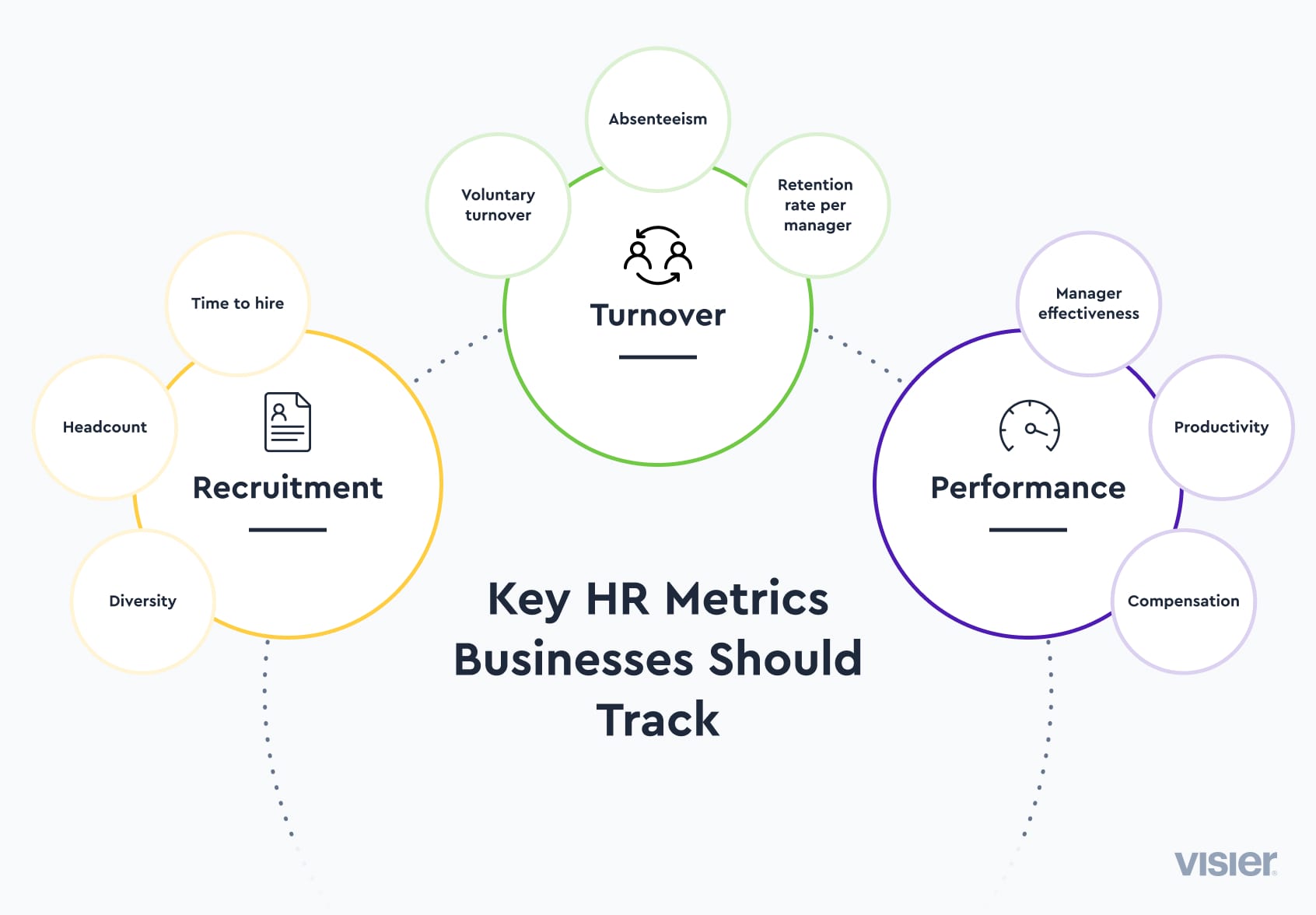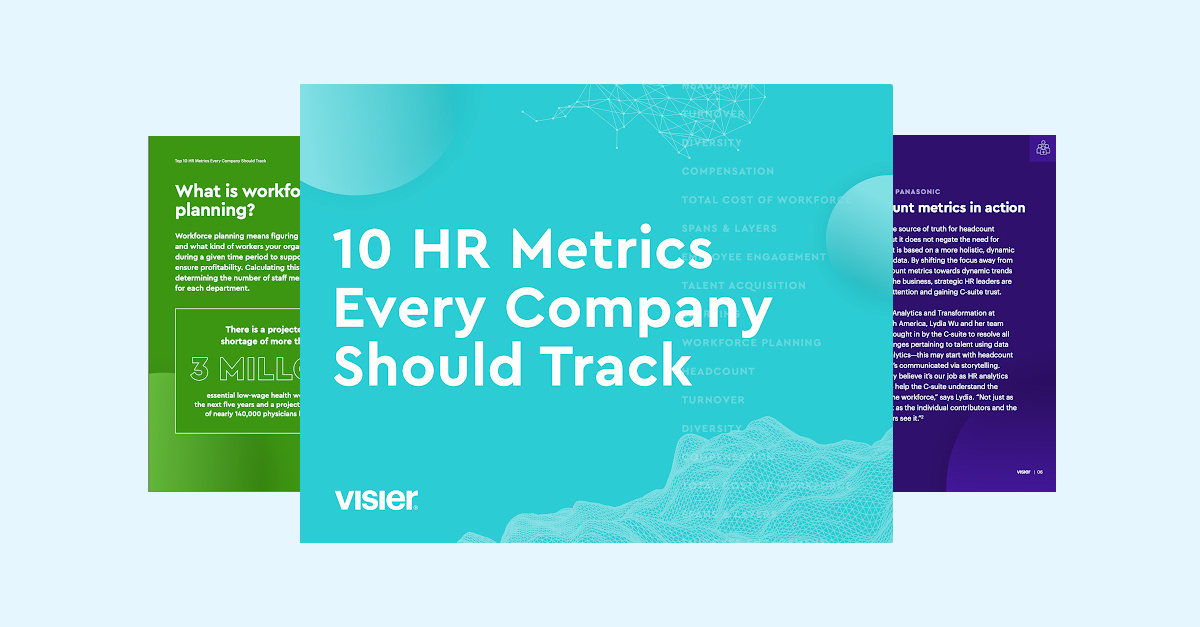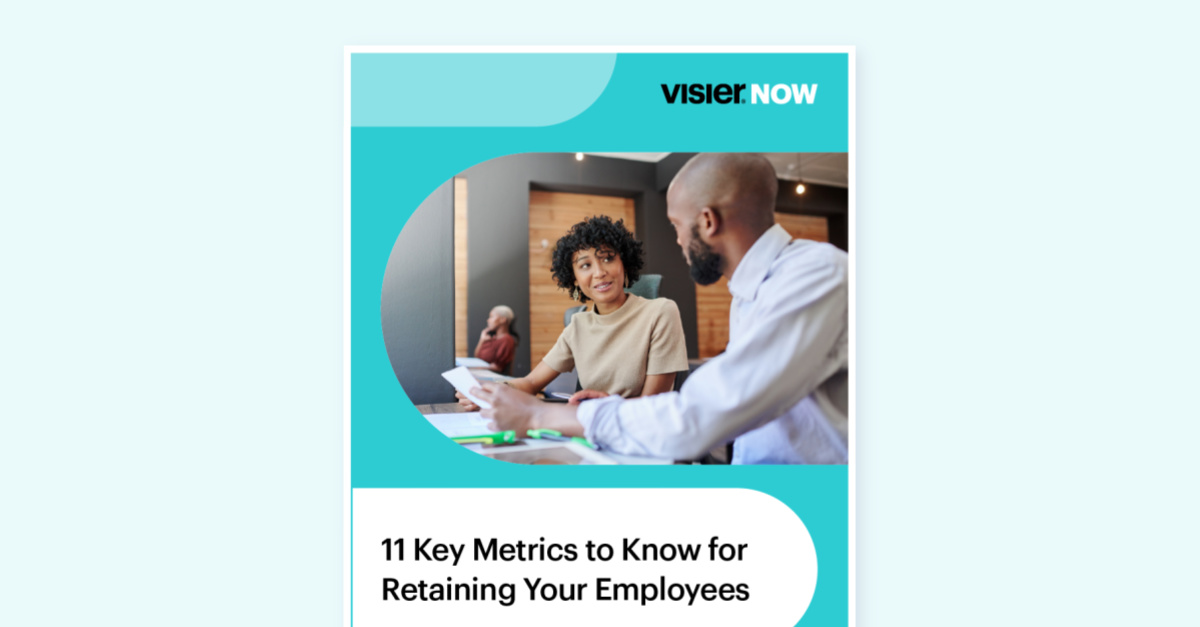HR METRICS
Everything You Need To Know About HR Metrics
HR metrics allow you to analyze critical areas of your business, measure programs and effectiveness, and deliver exceptional employee experiences. Read more to learn how to use them to drive business success.
Take a tour
Table of contents
What are HR metrics?Why you need to track HR metricsKey HR metrics you should track—and how to use themExamples of HR metrics in actionTrack and act on HR metricsWhat are HR metrics?
HR metrics, or human resource metrics, are data points that allow you to track various human resources and recruitment activities, such as retention, compensation, performance, time-to-hire, and more. Tracking these HR metrics over time allows organizations to keep tabs on how effective their strategies and programs are, and where they can be improved.
Human resources metrics allow you to assess critical areas of your business. They help you see what is working and what isn’t, and ultimately they may help you predict the future.
If you want to make more data-informed decisions, HR metrics are the way to go. They’re the first step towards people analytics and can help businesses measure how well their human resource initiatives are working.

Why you need to track HR metrics
People are one of the most valuable—and expensive— assets your business has. From the hiring and onboarding process to learning and development opportunities, and fair compensation, you continuously need to invest in your employees to maximize their impact.
Tracking HR metrics will show which strategies are working, which could use some changes, and where and if problems may arise in the future. Other benefits of HR metrics include:
Improved resource allocation for hiring, training, compensation, and more.
Better programs aimed to increase engagement, satisfaction, wellness, and performance.
The ability to analyze and predict the results of various changes within the company, including those regarding benefits, time off, team composition, location, and more.
Quickly and easily measuring employee experience. Employee engagement and satisfaction are critical to performance. Disengaged employees are more likely to quit when they find better opportunities and they often perform poorer before they do. Analyzing metrics allows you to get an idea of the employee’s level of engagement and solutions to help improve it.
In short, analyzing HR metrics can help you answer a few critical questions, such as:
Why are your employees resigning? — Look at turnover rates, satisfaction, engagement, and more.
How much does it cost to replace an employee? — Analyze cost to hire, time to hire, and other metrics related to the recruitment process.
What is the average time to productivity? — Again, analyzing various recruitment metrics such as time to hire, time to productivity or cost of hire can help.
Is my company paying equitably? — Here you’ll need to look at compensation, the total cost of the workforce, and other similar metrics. You also need to analyze how your salaries compare to the market.
Are my employees fatigued or risking burnout? — Tracking metrics related to burnout, satisfaction, absenteeism, and more can give you an idea of the burnout risk for your employees.
How does my U.S. company’s diversity compare to the EEOC guidelines? — If you want to compare to the EEOC guidelines, you first need to track metrics such as diversity and demographics.
Key HR metrics you should track—and how to use them
There are many HR metrics you can track in your business. The ones you choose depend, first and foremost, on your goals. For instance, if you want to improve your recruitment process, you can look at metrics like:
Headcount
Demographics
Diversity
Time to hire
Time to productivity
Cost per hire
Acceptance rate
Maybe you want to analyze and improve engagement and retention. In this case, you may consider metrics such as:
Voluntary, involuntary, and/or total turnover rates
Employee satisfaction
Absenteeism
Employee burnout
Retention rate per manager
Or perhaps you are interested in productivity and performance. Here, you can track things like:
The total cost of the workforce
Compensation
Manager effectiveness
Productivity
There are several more metrics that you can track depending on your goals. Let’s take a closer look at some of the most common ones, how to track them, and how they can help you.

1. Turnover
Voluntary turnover can lead to revenue losses. Finding someone new and training them can be a long and draining process.
To calculate turnover, divide the number of people who leave your company by the total number of employees.
You can choose to look at the total turnover or the voluntary one. Most companies prefer tracking the latter, as this is the number that signals potential problems within the company.
Use these metrics to estimate future resignations, and find drivers and patterns behind voluntary attrition.
Analyzing resignation rates can also help you spot problems in certain departments or with certain managers. Do you find most people who are resigning are coming from the same department? This might be a red flag.
2. Headcount
Headcount is the total number of people working in your company. It includes full-time employees, part-time and temporary ones, and gig workers.
This metric shows you if you have enough people to reach your goals. Once you have the total headcount, you can take it a step further and look at things like:
Permanent headcount
Temporary headcount
Part-time headcount
Gig worker headcount
You can also check the headcount in specific departments or locations instead of looking at everyone in the entire company.
3. Time to hire
This metric measures how long it takes to hire someone from the moment they apply until they accept the offer.
The hiring process can often be costly, so ensuring its efficiency is a must. By tracking this metric, you could spot various issues with the recruitment process, including a difficult or unclear application process.
Keep in mind that the time to hire is not the same as the time to productivity. It is a metric that looks only at the recruitment process.
4. Workforce planning
Figuring out how many and what kind of workers you need during a time period to support your organization is known as workforce planning. To calculate this metric, you’ll need to determine how many staff members you need in each department.
Without careful workforce planning, you’re at risk of lacking the people to achieve your business goals. You can use this metric to create recruitment strategies and determine your needs in terms of experience, qualifications, and skills.

Examples of HR metrics in action
Now that you know what HR metrics are and why they’re important, let’s take a look at how you can use them to improve your business.
Using turnover to better understand your global workforce
Merck KGaA, a German multinational science and technology company, had, until 2011, talent processes that were designed and driven by local countries or divisions. There were no global processes and no global view of the data.
This made it hard to understand the reasons behind their turnover rates. The reason someone quit their job in one country could be completely different from why someone quit the same job in another country. Merck KGaA knew it had to standardize its processes to create a cohesive, global data view.
In 2016, they implemented Visier and began using people analytics to understand why someone might leave the company. This helped them address turnover more effectively by building a prediction model on what makes people resign during their first year.
Prioritizing diversity
One of Wayfair’s top priorities is ensuring equal opportunity for everyone. They value data transparency and make it their goal to share people data with the talent team, managers, and leaders. They always try to find opportunities to create a more diverse workforce and ensure fair people processes.
By putting an emphasis on the diversity metrics, Wayfair could “tell the full story around outcomes for underrepresented talent at every stage of the employee lifecycle, from hiring through exit”.
This helped them spot problems before they affected overall business performance. It also allowed them to understand why these problems had occurred and how they could be solved.
Employee engagement at eBay
Implementing people analytics can make a tremendous difference in understanding employee engagement. eBay uses this data to analyze the employee experience and improve it where necessary.
They observe each program to see how impactful it is. At eBay, people data is used to learn from employees, to see what’s working and what isn’t, and to help managers understand how they can improve. By combining their people data and business data, eBay’s HR team can make data-driven decisions that improve the employee experience and benefit the company as a whole.
Compensation
If you want to keep the most talented employees, reduce turnover, and improve satisfaction, but also avoid wasting money, you need to watch the compensation metric.
Providence, a large healthcare system in the United States uses people analytics. In doing so, they were able to pinpoint those employees who would be more likely to remain in their jobs if given a pay raise.
They used past data, while also analyzing the cost of turnover and the value of the work the employee provided. This helped them identify highly skilled employees who could be motivated to stay through a pay raise.
By using this technique, they not only retained their most talented employees, but they were also able to save costs. Often, the cost of hiring someone new is much higher than offering a pay raise to someone who’s already been with you for a while.

Track and act on HR metrics
When used correctly, HR metrics can boost your business performance and help you reach your goals. Because people are at the center, a good place to start is people analytics. Use HR metrics and people data to understand your workforce and the workplace dynamics, prioritize diversity and inclusion, and more.
Start by answering questions related to the headcount, demographics, and understand how you compare to industry benchmarks. Bring data and people together for a more comprehensive solution to help you take your business to the next level.
Develop and retain your most valuable resource
Use HR metrics to take a closer look at more specific goals, such as the talent acquisition process. This is an area that can impact business productivity and performance. Get a dynamic pipeline view looking at everything from the candidate’s experience, the hiring source, and the quality of hire to the recruiter's capacity and time to fill.
It's equally important to understand how to keep your best talent, from what motivates employees to stay to what drives them to leave. By doing that, you can reduce voluntary turnover and ensure top employees want to stay with the company.
Create a thriving workplace
How your teams collaborate is often hard to understand, but crucial to a company’s success. Collaboration analytics help you understand how your teams work together so you can improve performance and productivity, increase employee engagement, and identify employee burnout before it turns into a serious issue.


